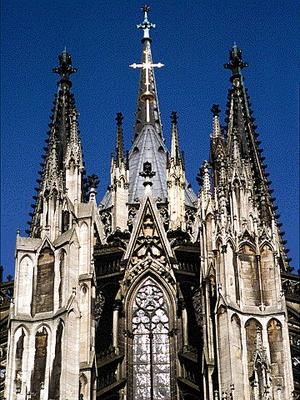The Gothic Cathedral of the Ages
 Cathedrals and other great churches always used to take a long time to build, but none quite like the Cathedral of Cologne.
Cathedrals and other great churches always used to take a long time to build, but none quite like the Cathedral of Cologne. For one thing, it took longer to build than perhaps any other church building in history. Construction began in 1248. It ground to a halt by 1560. It restarted in 1842 and...
For one thing, it took longer to build than perhaps any other church building in history. Construction began in 1248. It ground to a halt by 1560. It restarted in 1842 and...
was completed in 1880!
It should be no surprise that during the centuries of construction the dominant symbol of Cologne was the 14th century construction crane towering above the city.
Generally speaking, over the course of the decades and centuries that it took to build a cathedral, significant changes were usually made in the plans along the way.
Thus, a second remarkable thing about the long history of the construction of Cologne's Cathedral is that it essentially followed the same plan from the beginning. As it was being completed, the Cathedral of Cologne was widely hailed and widely imitated, inspiring St. Patrick's Cathedral in New York City. 
Then, less than 70 years after it was completed, this slowly wrought jewel was heavily damaged during the second World War.
Repairs were completed in 1956 and renovations have continued over the years since.

Like most Gothic cathedrals, the use of vertical space in the Cathedral of Cologne is awe-inspiring and beautiful, giving glimpses of heaven amid the shadows of earth.
The great windows are not only majestic and brilliant with color, but also educative and descriptive of the history of salvation and the mysteries of faith.

In most Gothic cathedrals, the statues appear to us today as cold, stern, lifeless, and sometimes even frightening. The 13th century statuary of the Cathedral of Cologne, however, includes statues that are lively, colorful, and even playful (sanctity does not have to be stuffy).
The east end of the Cathedral was the very first part to be completed. On the banks of the river Rhine it sits regally, like the most glorious of crowns.
 (Yes, I really, really like this cathedral!)
(Yes, I really, really like this cathedral!)
 A Penitent Blogger
A Penitent Blogger


<< Home